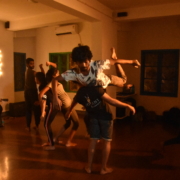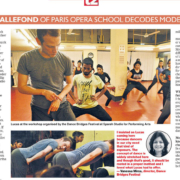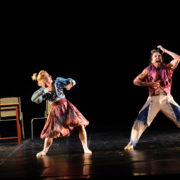Dance Bridges Festival had the privilege to interview renowned Israeli artist Ido Tadmor, celebrating over 30 years of an international dance career. Although schedules were tight, he and his dance partner for ‘The Empty Room’, Mira Rubinstein were in Kolkata for 48 hours especially to perform for Dance Bridges Festival 2017. Read the interview to know more about their experience and advice to young artists.
Dance Bridges: We are so happy to have you here with us for the second edition of Dance Bridges Festival (DBF). Could you tell us what interested you to participate in DBF?
Ido Tadmor: My partner for this piece, Mira and I were very happy to be invited for the Festival and to land here. For us it is very important to bring our art around the world as part of a handshake, a collaboration, a dialogue, as part of making sure that art is above politics, above society, above everything else. For us art is not only something that we like to do, it is a way of living; it is almost like a religion for us. When we get up in the morning, every day we do our class, we do our rehearsals as part of a message that we both carry. It is a message of love – as I said before – of dialogue, collaboration, and that is why a festival like this is very important. It is very easy for us to take a piece to Paris, London or New York City, but we do not often get to travel across the world to perform in such a special event. I was very happy to arrive here and so is Mira.
Dance Bridges: We heard that you have a very busy schedule but you still came all the way here for 48 hours. How did you to manage to fit this in?
Ido Tadmor: With great difficulty I have to say. I have been travelling all my professional life but especially in the last three and a half, almost 4 years. I have basically been living from a suitcase, travelling from one place to the next, with 6-7 different collaborations and 6-7 different productions. In Calcutta we will not even be able to stay until the end of the evening. We will be leaving immediately to the airport as we are heading back to Israel for 2 days before flying to Romania for 2 days, then Israel, New York, Los Angeles, Poland, New York again and Los Angeles. So the schedule is very tight. But as I said before, a performance like this is very important because it takes a great deal of will to create a Festival in a city like Kolkata that is not used to performances like these. For me it is more important to perform here than perform in Europe or the United States. Because it is a real message, it takes a great deal of dedication and will from the Festival team and from the artistic directors of DBF to create something like this and that is why we wanted to be a part of it.
Dance Bridges: Could you tell us about your experience so far in Kolkata and at DBF? Would you come back again?
Ido Tadmor: I will start from the end. Definitely, we will come back again. For me it is not the first time in India. It is my 6th time in India. I have actually been to Mumbai and Delhi. However it is the first time in Kolkata so it was a little bit of a shock. The mentality is completely different from ours. But I always found India to be fascinating, challenging with a special grain of magic in it I would say. I would call this the beauty of the mess. But I say it in the most positive way. It is as if I see life as it is. It is like a microcosm of the entire world. And it puts my life in perspective. I see the people here in India with such a kind and generous mentality; people are so nice, so friendly and that is why I always enjoy coming to India tremendously. The Festival has been conducted in the most professional way, the theatre is beautiful, the stage is beautiful and has a wonderful energy in it. So we will definitely come back, the question is whether you are going to invite us again!
Dance Bridges: Could you share with us something about your piece ‘The Empty Room’?
Ido Tadmor: This is a piece that was actually choreographed by the two of us. I always say that we choreographed it together because had it been someone else – other than Mira – it would have been a completely different piece. Mira and I are very close to each other and we have a very special bond. A part of this bond is that we like to tease each other, to play games together and I think this came into the piece. ‘The Empty Room’ is about this couple who meet at a young age and grow older together. In the end, the man loses his wife and this is why it is called ‘The Empty Room’: when he comes back to the room, it is empty… from her.
So we tried to stretch it from the funniest place to the saddest place. Like in life, we unfortunately all lose people we love in different ways. It is a tremendously difficult thing to go through. It is difficult but it is something we have to go through. This piece was performed in many different places around the world including the Bolshoi Theatre in Russia which is one of the most amazing theatres in the world. We are always very curious to see how the audience will respond; because it is a very quirky funny piece but not everyone understands it. It is very different from what we are used to doing. We are classical modern dancers and this piece has a very strange atmosphere and movement style, so we enjoy the challenge.
Dance Bridges: We hear that you’re celebrating 38 years of international dance, could you tell us about your journey so far?
Ido Tadmor: Well I am very blessed in my career, blessed to be a principal dancer with some very special companies and I am also now a guest dancer with many different internationally renowned companies. It is a life that I chose and it is not very easy to live on airplanes all the time and not to have…, I have my own home in Israel but not to be there all the time. But it is a life that I chose, a life that is challenging and one I am very happy to live. So, I think for me, it was never enough to just dance. For me it was about meeting people, it was about teaching people, it was about working with collaborators and choreographing for people in different countries, actually trying to explore dance on all sides and that is why it is very important for me to see and get to know different mentalities. I have really travelled all around the world – the Far East, Europe, Eastern Europe, North America, South America, Africa… Really traveling and meeting many wonderful people, artists. I think that in general – Mira and I talk about it a lot – we feel very blessed that this is our life. It is not very easy but that is not a complaint, just a fact. As long as we can do it, we will continue doing it.
Dance Bridges: If you could say something to inspire young dancers in this field, what would you tell them?
Ido Tadmor: WORK, WORK AND WORK. For me the most important talent one can have is the talent of work. I have seen wonderful dancers with wonderful facilities and great technique. Basically they utilize 40 or 50 per cent of their talent. And I have seen less talented people who had the talent of work and they utilized 100 percent of their talent. So if I could inspire someone, it is by presenting myself as someone who loves to work. I work all the time, every day from morning to evening, sometimes until night. I think it is the work and the dedication that I put into my art that took me all over the world. So for me the most important thing is to experience, to work, to research deeply and then just send it to the world.
And to close, I just want to say, in our profession we meet so many dancers, great dancers and we rarely find great partners because it is about chemistry. It is like in life when you fall in love with someone, it can be a good marriage or a bad marriage. We are not married but we – Mira and I – have a good marriage as dance partners. Because our friendship really comes into rehearsals and onto stage and this is very rare. I feel very blessed that Mira is here with me to share this wonderful experience. Thank you for the generosity and everything, it has been really heart touching.
[Special thanks to Ido Tadmor and Mira Rubinstein for being with us at Dance Bridges Festival 2017. The performance of ‘The Empty Room’ was made possible by the support of the Embassy of Israel (New Delhi), as part of the celebrations of 25 years of diplomatic relations between India and Israel.]





